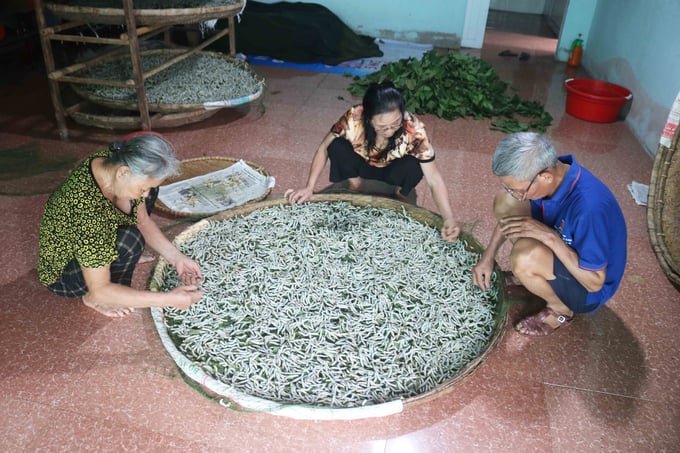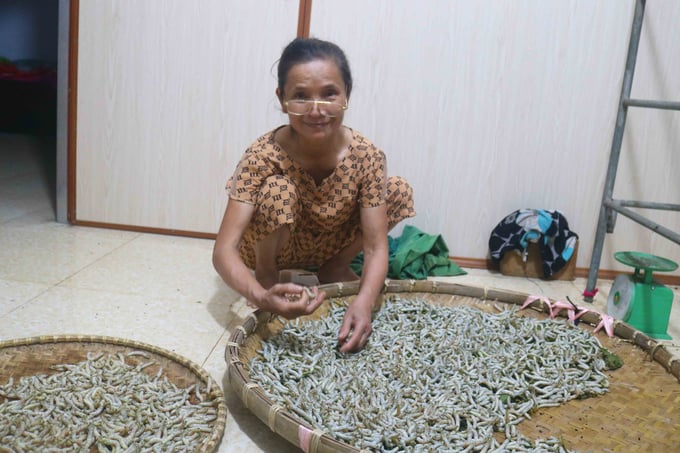Silkworm farming and silk weaving have a long tradition in Khanh Son Township in Nam Dan (Nghe An) District. Over the years, people here have switched to raising silkworms for food, initially establishing high-tech silkworm farming cooperatives, opening up new prospects for the land along the Lam River.
Food silkworms are in short supply and at a good price
Present at the home of Ms. Pham Thi Nguyet (50 years old) in Hamlet 4, Khanh Son Township, when the second generation of silkworms were eating, in a newly built spacious wooden house with 9 bamboo shoots placed in parallel on the shelves. heavy iron. Silkworms crawled on the hot surface and had only a few days left to mature.

The people of Khanh Son Township have been cultivating the profession of mulberry cultivation and silkworm breeding for a long time. Picture: Huy Thu
Ms Nguyet said her family was living with another family in the village this year. The first batch of silkworms produced 2.5 round eggs and 12 silkworm larvae and sold VND 7 million, minus the cost, also brought in VND 6 million. The second generation of silkworms laid only two rounds of eggs due to the reduced number of mulberry leaves.
According to Ms. Nguyet: “Raising silkworms costs less capital, costs less, turns around quickly, just takes care of it. After more than three weeks of having cash in hand, each litter also brings in several million dongs.” Compared to raising other plants and animals, raising silkworms is the most profitable, so my family has been cultivating the profession for many years of silkworm farming as food.”
With Mr. Pham Giang Nam’s family, a household in the same village, he not only breeds silkworms but also provides seed silkworm eggs to the people of the area. Over the years he and his wife have used 5 hectares of land to grow mulberries for silkworm breeding. This mulberry range is enough to rear 2-3 egg rings, which equates to 8-12 silkworm larvae/brood.
Mr. Nam’s family used a spacious roadside house to raise silkworms. As someone who “hangs around by the nose” to supply the whole neighborhood with silkworm eggs, his family collects eggs for their own rearing and sells eggs to relatives every month.

Mulberry cultivation for breeding silkworms, especially silkworms for food, is developing very well in Nghe An at present. Picture: Huy Thu
Mr. Nam shared, “Although silkworm rearing is not difficult, it requires perseverance and hard work. When silkworms “eat up”, feed 6-7 times every day and feed all night. The people here are currently cultivating local traditional mulberry varieties with soft green leaves and cultivating yellow Thai Binh silkworms, which are small but of good quality. In this era of “chemical disorder,” silkworms are a clean food favored by many.
Currently, there are dozens of households raising silkworms in Khanh Son Township. The people here mainly breed pure Vietnamese silkworms and yellow silkworms in each household, which are resistant to hot and humid weather, rarely get sick, and have good product quality. Households often use the area of the house and kitchen to raise silkworms. For each silkworm litter, a household breeds 1 to 3 egg rings (corresponding to 4 to 12 silkworm larvae).
According to relatives, the time for raising food silkworms is the period from February to October of the lunar calendar. At the beginning of this year’s silkworm season, the weather was quite favorable and all silkworm casts developed well. Growing mulberries to raise silkworms, people have gained a lot of experience, especially creativity in using plastic nets to line silkworms.

Feeding silkworms is not difficult, but it requires perseverance and hard work. Picture: Huy Thu
After the silkworms eat all the mulberry leaves, just lift the net to change the heat instead of picking up each silkworm like before, which is very troublesome. Pham Thi Tuyet (64 years old), Mr. Nam’s wife, said: From around mid-January lunar calendar, people here start breeding silkworms and it usually lasts until around October lunar calendar (a break from farming in winter) . .
The basic advantage of food silkworm farming here is that there is no need to worry about production. The golden silkworm in Khanh Son is a nutritious food that can be made into many delicious and attractive dishes, chosen by locals and customers from near and far. Currently, fresh silkworms are sold at around VND 110,000/kg.
When the silkworms are ripe, customers come to their homes to buy them, they don’t have to take them to the market, and some homes even have pre-orders. In addition to the silkworms, dried silkworm dung is purchased from traders at a price of VND 500,000/quintal. The need for food silkworms among the population is great (for family meals, pubs, restaurants, etc.), which represents potential for silkworm farming in the area.

Pham Giang Nam’s family breeds silkworms and provides seed silkworm eggs to farmers. Picture: Huy Thu
The greatest concern people have today is the origin of seeds and food. Silkworms are brought by traders from the north, so people are quite passive about the origin of the seed eggs. When eggs are needed, they are not available, when available, they are raised at once, the whole village has nine silkworms at once.
In order to breed silkworms, you need to grow mulberries. Recently, households raising silkworms here have used large areas of alluvial land along the Lam River to grow mulberries. Every November, people will prune mulberries, weed and fertilize in preparation for next year’s silkworm harvest. The mulberry area determines the number of silkworms raised in the nest. Currently, breeding silkworms is profitable. Many households want to increase the number of silkworm larvae, but there are not enough sources of mulberry leaves.
Founded a high-tech mulberry cooperative
Mulberry and silkworm cultivation has been practiced in Khanh Son Township for a long time. Previously, alluvial plains along the Lam River from Vuc Don Wharf to Hoanh Son Community House were green and strawberry colored. The house grows mulberries and raises silkworms. In the village outside the village, you see the silk gardening and silk weaving scene everywhere you go. At that time, silkworm farming flourished in Dong Son Village. In addition to silk production, people also wove silk fabrics to sell in markets.

People select silkworms to sell when the silkworms are mature. Picture: Huy Thu
In the silkworm season, every house is bright yellow with cocoons, the garden is full of silk and silk. However, during the collective business era, the idea of incubating silk to obtain cocoons only flourished for a time and then faded into oblivion. Out of hundreds of families engaged in silkworm breeding and silk weaving, only a few dozen households remained in the occupation. In recent years, most silkworm farming households in Khanh Son have switched from silkworm farming for cocoons to silkworm farming for food due to market demand.
In addition to raising food silkworms, agricultural mulberry cooperatives have been established in the area, breeding new varieties of silkworm and mulberry.
Mr. Ngo Duy Khanh, director of Dong Tien Hi-Tech Mulberry Agriculture Cooperative, said the entity was only established in 2020 but has built a relatively modern system of rearing and sericulture facilities. Silkworm breeds from China and the Central Silkworm Research Center are bred here, using new silkworm breeding techniques. Small silkworms that are “eat fashion, eat two” are raised in an air-conditioned room, and “eat three” or higher silkworms are reared in the middle of the concrete floor, and are not used like traditional silkworm rearing.

When ripe silkworms turn pink, they can be made into delicious dishes. Picture: Huy Thu
According to Mr. Khanh, the unit employs about 10 local workers to take care of mulberries and silkworms and has planted 16 hectares of new mulberry varieties (GQ20, VH15) and will plant another 4 hectares in the coming period. The cooperative advocates rearing and raising silkworms, but will be cocooning and hatching silk for testing in the near future. Average 2kg of silkworms for 1kg of cocoons, 5.5kg of cocoons for 1kg of silk.
Currently, the cocoons produced by the cooperative are not enough to sell them. Some households in the area have recently recognized the practical implications of breeding new breeds of silkworm and have also preserved the cooperative’s varieties to breed, expand and spread silkworm farming in the area.
Khanh said that raising silkworms for cocoons using the farm model has initially achieved feasible results and promises to open new perspectives in utilizing land and labor potential and creating more products. It helps create jobs and increase people’s incomes.

Currently, many households in Khanh Son have access to a new source of silkworm seeds for high productivity and quality, as well as raising silkworms for cocoons on concrete floors. Picture: Huy Thu
In Nghe An, in addition to Khanh Son Township (Nam Dan), some places in other districts such as Do Luong, Thanh Chuong, Dien Chau, etc. also engage in silkworm farming, including silkworms for food and silkworms for cocoons.
The preservation and promotion of traditional silkworm farming not only provides a good source of income for farmers, but also utilizes the potential and advantages of the place.
Although there are many advantages in terms of natural conditions, production experience, market demand, etc., in general, silkworm farming in local areas is small and seasonal. In order to expand the scale and promote the movement of mulberry cultivation to silkworm breeding, people need to deal with many issues and attract the attention of all levels of sectors and the association in the production and consumption of products.

